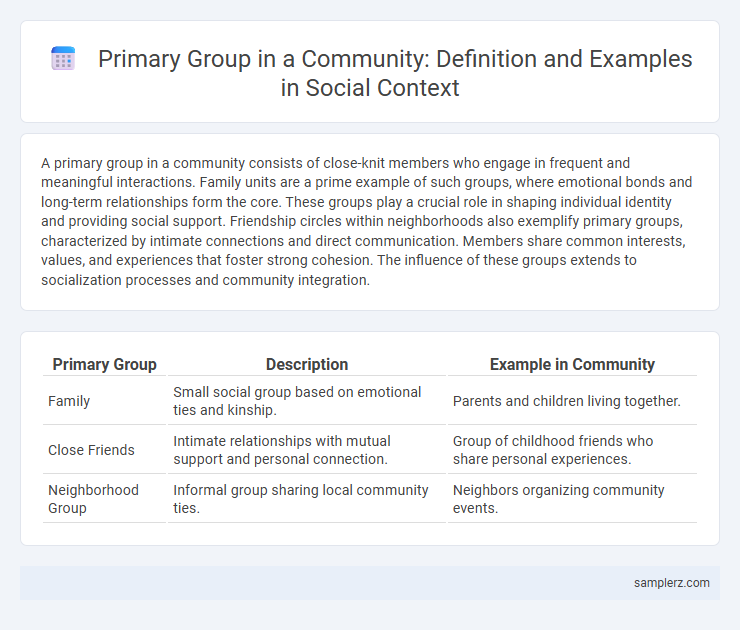A primary group in a community consists of close-knit members who engage in frequent and meaningful interactions. Family units are a prime example of such groups, where emotional bonds and long-term relationships form the core. These groups play a crucial role in shaping individual identity and providing social support. Friendship circles within neighborhoods also exemplify primary groups, characterized by intimate connections and direct communication. Members share common interests, values, and experiences that foster strong cohesion. The influence of these groups extends to socialization processes and community integration.
Table of Comparison
| Primary Group | Description | Example in Community |
|---|---|---|
| Family | Small social group based on emotional ties and kinship. | Parents and children living together. |
| Close Friends | Intimate relationships with mutual support and personal connection. | Group of childhood friends who share personal experiences. |
| Neighborhood Group | Informal group sharing local community ties. | Neighbors organizing community events. |
Family Units: The Core of Primary Groups
Family units serve as the fundamental example of primary groups within a community, providing emotional support, socialization, and a sense of belonging. These intimate groups, composed of parents, siblings, and close relatives, shape individual identities and social norms through consistent interaction and mutual care. The strength of family bonds significantly influences community cohesion and personal development across cultures.
Close Friend Circles in Neighborhoods
Close friend circles in neighborhoods exemplify primary groups, characterized by intimate, face-to-face interactions and strong emotional bonds. These groups provide essential social support, trust, and a sense of belonging among members. Their continuous involvement fosters community cohesion and personal identity within the local social structure.
Peer Groups Among Adolescents
Peer groups among adolescents serve as primary groups within communities, providing essential social support, identity formation, and emotional bonding. These groups influence behavior, values, and social skills during critical developmental stages, fostering a sense of belonging and mutual trust. Characteristics of adolescent peer groups include frequent interaction, shared interests, and emotional closeness, distinguishing them from secondary social structures.
Support Groups for Shared Life Experiences
Primary groups in communities often manifest as support groups for shared life experiences, such as grief counseling groups for bereaved individuals or addiction recovery circles like Alcoholics Anonymous. These groups provide emotional support, foster deep personal connections, and enhance coping mechanisms within a trusting environment. The intensity and intimacy of interactions in these groups contribute significantly to members' psychological well-being and social integration.
Religious Fellowship Circles
Religious fellowship circles exemplify primary groups within communities by fostering close-knit relationships built on shared faith and mutual support. These groups facilitate regular interpersonal interactions, emotional bonding, and collective rituals that strengthen social cohesion. Through active participation, members experience a sense of belonging and identity integral to community solidarity.
Childhood Playgroups within Communities
Childhood playgroups serve as primary groups within communities by fostering early socialization, emotional bonding, and cooperative skills among children. These intimate, face-to-face interactions in playgroups promote identity formation and social norms adherence during critical developmental stages. Parents and caregivers in childhood playgroups also form supportive networks that enhance community cohesion and child development outcomes.
Workplace Teams with Personal Bonds
Workplace teams with personal bonds represent a prime example of a primary group in a community, characterized by close-knit relationships and mutual support among members. These teams foster trust, cooperation, and emotional connections that enhance collaboration and productivity. Strong interpersonal ties within workplace teams contribute to a sense of belonging and collective identity, essential for social cohesion.
Elderly Social Clubs and Connections
Elderly Social Clubs serve as prime examples of primary groups within communities, fostering close-knit relationships through regular social interactions, shared activities, and mutual support. These clubs enhance emotional well-being and combat loneliness by creating a sense of belonging and trust among elderly members. Through consistent engagement, members establish strong interpersonal bonds that contribute significantly to their social identity and community integration.
Volunteer Groups with Deep Interpersonal Ties
Volunteer groups in communities exemplify primary groups by fostering deep interpersonal ties through shared goals and sustained interaction. Members develop strong emotional bonds and trust while collaboratively addressing local needs such as organizing food drives or community cleanups. These close-knit relationships enhance social cohesion and collective identity within the community.
Parent-Teacher Associations as Primary Groups
Parent-Teacher Associations (PTAs) serve as primary groups within communities by fostering close-knit relationships among parents and educators focused on student development and school improvement. These groups facilitate face-to-face interactions, mutual support, and shared goals, which are key characteristics of primary groups promoting social cohesion. Through regular meetings and collaborative activities, PTAs strengthen trust and emotional bonds crucial to community engagement and collective decision-making.

example of primary group in community Infographic
 samplerz.com
samplerz.com